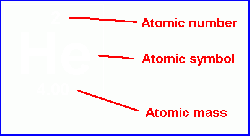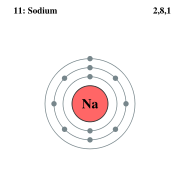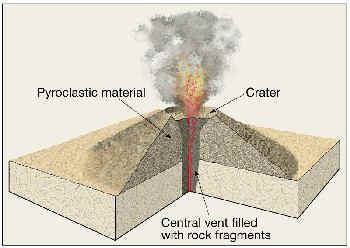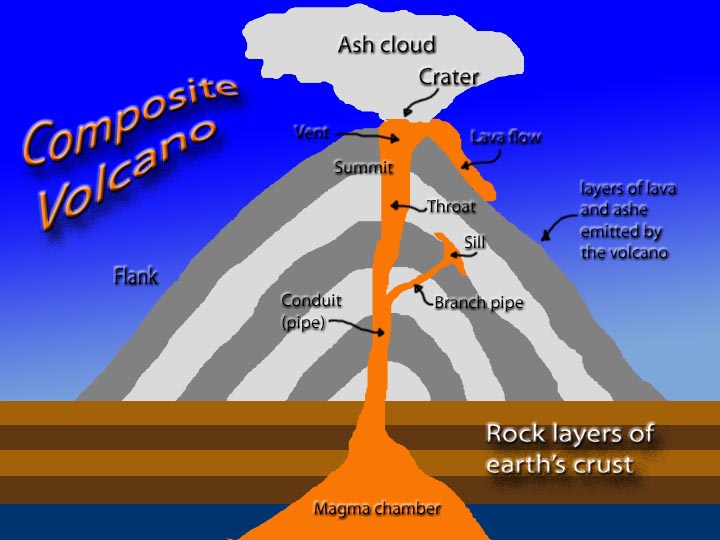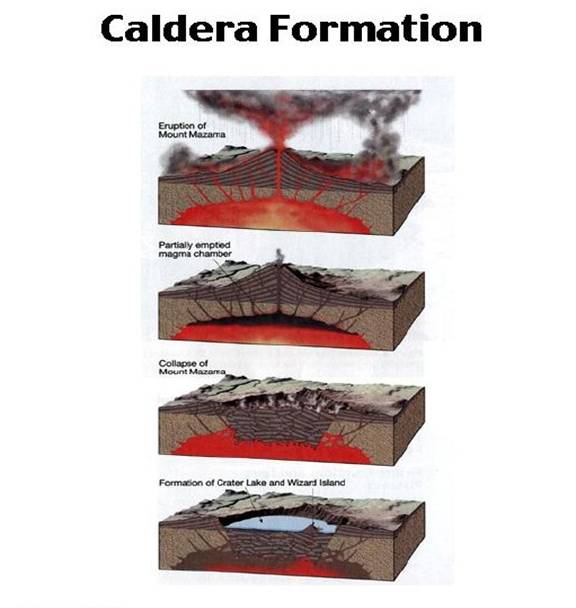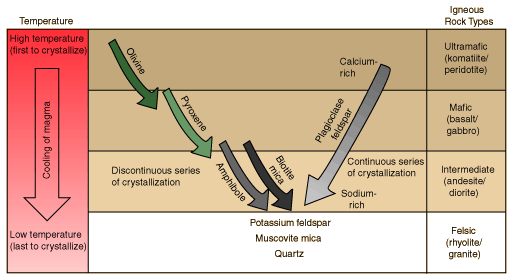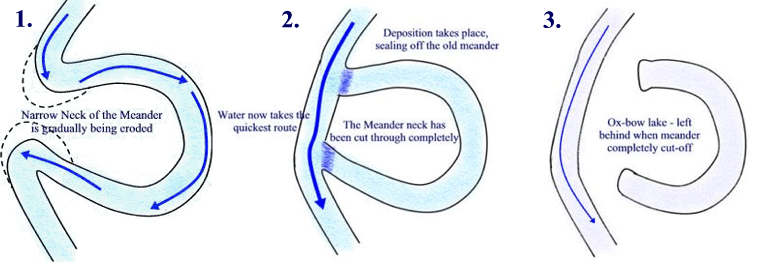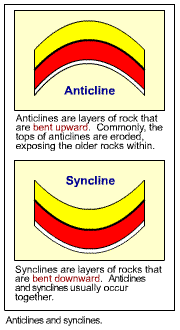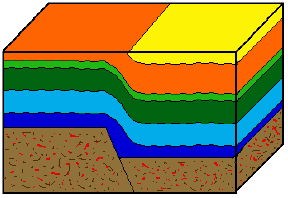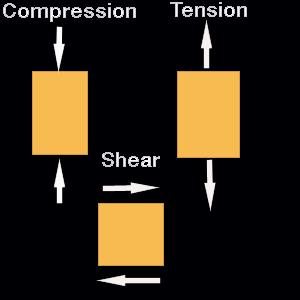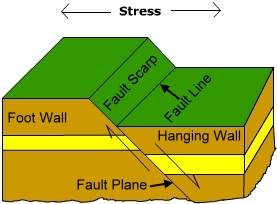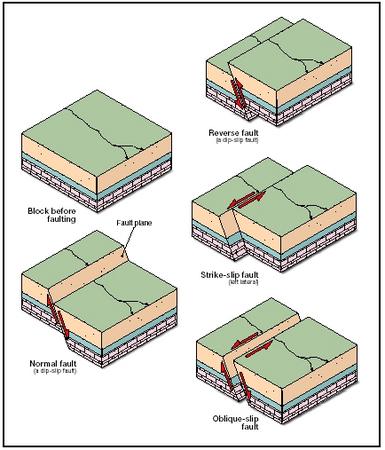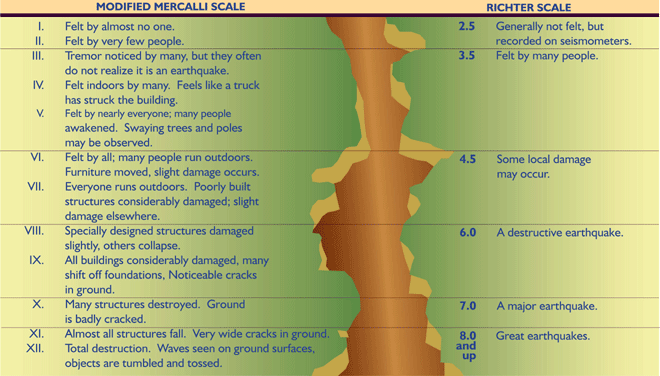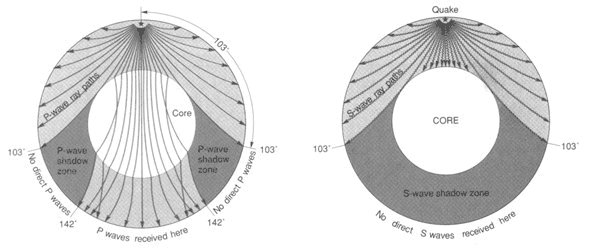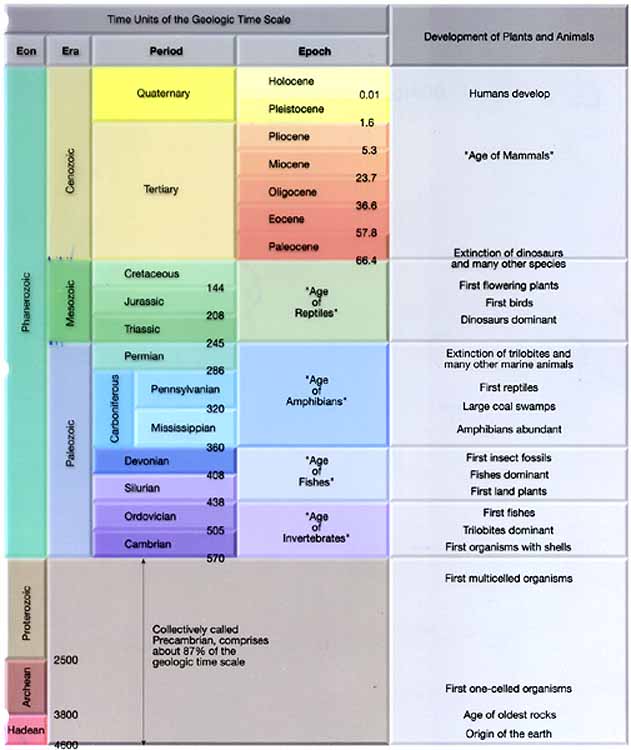GMOA Notes
These are notes that cover Geology, Meteorology, Oceanography, and Astronomy. They are designed to give a basic understanding of most of the topics covered in the various Earth Science events, including Dynamic Planet, Rocks and Minerals, Meteorology, Fossils, Solar System, Reach for the Stars, Astronomy, and Oceanography.
Introduction
Earth's five spheres-Earth's climate system
Hydrosphere - dynamic mass of liquid that is always on the move
- Oceans - the most prominent feature of the hydrosphere
- 71% of Earth's surface is covered by ocean which is 97% of Earth's water
- Only 3% is fresh water - streams, lakes, glaciers and underground supplies
- Water Cycle - constantly recycles water
Atmosphere
- Provides us with the air we breath
- Protects us from the sun's intense heat and radiation
- Protects us from space
Biosphere
- Includes all life on Earth
- Interacts and influences the other 3 spheres
Lithosphere
- Earth's rigid outer layer called the crust and the upper mantle called the asthenosphere
- Solid earth consists of 4 layers:
- core
- inner, solid core
- outer, liquid core
- mantle
- lithosphere
- core
- Divisions of Earth's surface
- continents
- ocean basins
Cryosphere - the portions of Earth covered by water in solid form
Sciences
Sciences involved in better understanding the earth integrate chemistry, physics, and biology into the following sciences:
Meteorology - the study of:
- the atmosphere
- weather and climate
Geology - the study of the Earth, and is broken into
- Physical geology
- minerals
- rocks
- Earth processes - mountain building, earthquakes, volcanoes, etc.
- Historical geology - Earth's origin and it's past
- physical
- biological
Oceanography - study of the Oceans
- Composition and movement of seawater
- Seafloor topography and sea life
Astronomy - the study of the universe
- Earth is a tiny object in a vast universe
- to understand Earth helps us to understand other planets and vice versa
Resources and Environmental Issues
Environment
- Physical environment (abiotic)
- water
- air
- soil
- rock
- Biological - living environment (biotic)
Resources
- Important environmental concern
- Include:
- water
- soil
- minerals
- energy
- Two broad categories of resources
- Renewable resources
- can be replenished
- Examples: plant (lumber) and wind energy
- Nonrenewable Resources
- Fixed quantities
- Examples: fuels and metals
- Renewable resources
Environmental Problems
- Local, regional, and global
- Human-induced and accentuated
- Urban air pollution
- Acid rain
- Ozone depletion
- Global Warming
- Natural Hazards
- Earthquakes
- Landslides
- Floods
- Hurricanes
- World population pressures - in 30 years population increased from 4 to 7 billion
- US makes up 6% of that but uses 30% of the annual mineral and energy resources
- Alternate energy sources needed
Scientific Inquiry
Scientific Inquiry - scientific knowledge is gained through the following systematic steps called the scientific method, (PI-HE-RAC)
Gather facts through observation then ask why?
- Problem - state the problem
- Information about the problem
- Hypothesis (untested best guess as to why)
- Experimentation
- Record and Analyze results
- Conclusion - accept or reject hypothesis
Goal of science is to discover patterns in nature and use knowledge to predict what will happen under certain circumstances
- Theory - tested and confirmed
- Law - no known deviations have ever been found
Minerals
A mineral is a naturally occurring crystalline solid with a definite but not fixed chemical composition and ordered atomic arrangement.
Chemistry and Mineral Terms
Chemistry Terms:
- Chemical Property - characteristics of a material, which depends upon how the material reacts with other materials
- Periodic Table - list of all known elements
- Element - matter made up of atoms that are essentially all the same and cannot be subdivided by ordinary chemical methods
- Atom - smallest part of an element
- Nucleus - central part of an atom made up of protons and neutrons
- Protons - subatomic particles with a positive charge
- Electrons - subatomic particles with a negative charge
- Neutrons - subatomic particles with a charge of 0
- Atomic number - the number of protons in an atom (above element symbol on periodic table)
- Atomic mass - the number of protons plus the number of neutrons (below element symbol on periodic table)
- Isotope - change in the number of neutrons in an atom. Example, and isotope of sodium may have 10 or 12 neutrons
- Electron Configuration - how the electrons are arranged around the atom in energy levels
- 1st energy level has 2 electrons
- all other energy levels have 8 electrons
- Ion - change in the number of electrons
- Atoms are most stable with 8 electrons in the outer energy level
- Will share, lose, or gain electrons to achieve this
- Ionic bonding - transfer of electrons
- example - Sodium and Chlorine
- Lewis Electron Dot Structure - Short hand for showing "chemistry" activity in the outer level by showing the number of electrons in the outer energy level
- Covalent bonding - sharing of electrons. VERY STRONG BOND
- example - bond between Hydrogen and Oxygen
- Metallic bonding - electrons do not belong to any particular nucleus, they float between nuclei
- example - two metals touching for a long time can "weld" to each other by metallic bonding. You can increase the speed of this by adding heat.
Mineral Terms:
- A mineral is a naturally occurring crystalline solid with a definite but not fixed chemical composition and ordered atomic arrangement
- Size of the ion is important because ions that are within 10% of the same size may be substituted in many minerals. This is why minerals of the same type have different chemical compositions.
- examples - Si,Al; Fe,Mg; Na, Ca
- Size of the ion is important because ions that are within 10% of the same size may be substituted in many minerals. This is why minerals of the same type have different chemical compositions.
| Element | % by Weight |
|---|---|
| Oxygen, O | 47 |
| Silicon, Si | 28 |
| Aluminum, Al | 8 |
| Iron, Fe | 6 |
| Calcium, Ca | 4 |
| Sodium, Na | 3 |
| Magnesium, Mg | 2 |
| Potassium, K | 2 |
- Mineral formation
- Melting - Volcanic activity
- Evaporation - Salt water: Halite, Gypsum
- Biological activity - sulfur producing bacteria
- Oxidized - comes into contact with oxygen: Limonite
- Leached - as water moves through the soil it dissolves elements. A leech line forms due to mineral formation where the water stops: bauxite
- Metamorphic processes - formed by heat and pressure. Examples: graphite, chlorite, diamonds. Alters chemical composition and structure, called recrystallization
- Mineral Types
- Native minerals - contain one element
- examples - graphite, C; Copper, Cu; Sulfur, S
- Sulfides and Sulfates - contain Sulfur and other elements
- Silicates - contain silicon and other elements
- Oxides - contain oxygen and other elements
- Carbonates - contain CO3 and other elements
- will effervesce in the presence of an acid
- Phosphate - contains PO4 and other elements
- Native minerals - contain one element
- Physical Property - is controlled by the chemical properties of a material...how its bonded can determine the hardness and the type of impurities that are present in its change in color
- Color - reflected light; very poor indicator of the true color due to impurities
- Streak - true color of the mineral found by powdering it. This is found by scratching the mineral across a streak plate.
- Hardness - the resistance to scratching
| Hardness | Mineral | Common Tool |
|---|---|---|
| 1 | Talc | Fingernail |
| 2 | Gypsum | Fingernail |
| 3 | Calcite | Penny |
| 4 | Fluorite | Nail |
| 5 | Apatite | Nail |
| 6 | Orthoclase | Glass |
| 7 | Quartz | Streak Plate |
| 8 | Topaz | |
| 9 | Corundum | |
| 10 | Diamond |
- Cleavage - the tendency for a mineral to break along flat smooth planes that reflect light
- This is controlled by a weakness in structure, may break where bonds are longer or fewer
- predictable pattern, not random
- 1 perfect - stacks like sheets of paper, example: mica
- 2 perfect - break in two directions and is very clear, example: calcite
- 3 cubic - breaks into perfect cubes, example: halite
- none - no repeating faces
- conchoidal fracture - concentric circles are around breaks, irregular fracture pattern, example: quartz
- Magnetism - minerals that contain iron and are polarized, example: magnetite
- Taste - how they taste: bitter, sweet, salty
- Luster - appearance
- metallic - look like metal
- nonmetallic - look earthy
- Density = mass/volume
- Specific gravity - how heavy something is in air compared to how heavy it is in water
- Radioactivity - the breakdown of atoms in the nucleus
Mineral Key
This is not a full table of minerals.
| Hardness | Color | Streak | Cleavage | Remarks | Name | Composition |
|---|---|---|---|---|---|---|
| 1 to 1.5 | Steel Grey to Iron Black | Black to Grey | 1 Perfect | Metallic Luster, Greasy feel-marks paper, Use Pencil Lead | Graphite | C |
| 2.5 | Blue-Black to Lead Grey | Grey-Black | 3 Cubic | Cubic cleavage, High Specific Gravity, Metallic Luster, Use-Lead Ore | Galena | PbS |
| 2 to 2.5 | Reddish | Red | 2 perfect | Usually Granular, Distinguished by Red Streak, Use-Mercury Ore | Cinnabar | HgS |
| 1 to 1.5 | Blue-Black | Greenish Black | 1 perfect | Metallic Luster, Greasy feel, use-Molybdenum Ore | Molybdenite | MoS |
| 2.5 to 3 | Black to Dark Green | Brownish Black, Green Black to Colorless | 1 perfect | Perfect cleavage 1 direction, commonly in stacks or sheets--one on the micas | Biotite | K(Mg,Fe)3(AlSi3O10)(OH)2 |
| 2 to 2.5 | Colorless | Colorless | 1 perfect | Perfect cleavage 1 direction, commonly in stacks | Muscovite | KAL2(AlSi3O10(OH)2 |
| 1 | White or Grey | White to Greenish White | 1 perfect | Greasy feel, non-metallic luster, use-talcum powder | Talc | Mg3Si4O10(OH)2 |
| 2 | Colorless to White | White to Colorless | 1 perfect | Perfect cleavage i direction, may be fibrous, use-sheet rock | Gypsum | CaSO4+H2O |
| 2 to 2.5 | Green | Green | 1 perfect | Feels greasy, use-fertilizer | Chlorite | (Mg,Fe)3(Si,Al)4O10(OH)2S/sub> |
| 1 to 2 | White | White | None | Absorbs water, greasy feel, one of the clay minerals, use-kaolinite | Kaolinite | Al2Si2O5(OH)4 |
| 1.5 to 2.5 | Yellow | Yellowish White | None | usually granular, streak smells like sulfur, use-chemical industry | Sulfur | S |
| 1 to 3 | Brown, Yellow Orange to White | Yellowish to White | None | Rounded grains, usually clay like, use-aluminum | Bauxite | Al(OH)3 |
| 3 | White to Colorless | Colorless | 3 perfect not at right angles | effervesces with HCl, shows double refraction, use-calcium | Calcite | CaCO3 |
| 3 | Gray to colorless | Colorless | 3 perfect hard to see | A type of calcite, effervesces with HCl, usually massive | Aragonite | CaCO3 |
| 2 to 2.5 | Colorless to White | Colorless to White | 3 perfect at 90 degrees | Tastes salty, soluble in water, use-salt | Halite | NaCl |
| 1.5 to 5 | Yellow, Brown, Orange-Brown | Rusty yellow, Brown-red | None | Characterized by rusty streak, mars mineral, use-iron | Limonite | FeO |
| 2.5 to 3 | Copper Red, Green Tarnish | Copper Red | None | Metallic Luster with distinctive streak, use-copper | Copper | Cu |
| 3.5 to 4 | Bright Brassy Yellow | Green yellow, Brassy brown | None | Distinctive color, metallic luster, use-minor copper ore | Chalcopyrite | CuFeS2 |
| 3.5 to 4 | Brown-yellow, Orange-black | Yellow | 6 directions difficult to detect | gives sulfur smell when powdered on streak plate, use-zinc | Sphalerite | ZnS |
| 3.5 to 4 | Azure Blue | Light Blue | 1 perfect | Commonly found with green malachite | Azurite | Cu3(CO3)2(OH)2 |
| 4 | Light Purple or Yellow | Colorless | 3 perfect difficult to see | Effervesces with HCl when powdered | Dolomite | CaMg(CO3)2 |
| 4 to 5 | Dark to Light Green | White | None | Chief source of asbestos | Serpentine | Mg2Si2O5(OH)4 |
| 5 | Green or Brown | White | 1 poor | use-making fertilizer | Apatite | Ca5(PO4)3(F,Cl,OH) |
| 5 to 6 | Pale Yellow to White, Green | Colorless | Conchoidal Fracture | Characterized by pale yellow color, precious opal, shows play of colors | Opal | Si)2+H2O |
| 5 to 6 | Black | Dark grey to colorless | 2 perfect at 60 and 120 degrees | one of amphibole group, cleavage makes it appear to be in layers | Hornblende | (Ca,Na)2,3(Mg,FeAl)5Si6(Si,Al)2O22 |
| 6 to 6.5 | Steel Gray or Red Brown | Red Brown | None | Forms ranging from earthy to specular, use - iron ore | Hematite | Fe2O3 |
| 5.5 | Shiny Black to Brown | Dark Brown | None | Use - chromium ore | Chromite | FeCr2O4 |
| 5.5 to 6 | Black | Black to Dark Gray | None | Magnetic, Use - Iron Ore | Magnetite | Fe3O4 |
| 6 | Orange-pink | White to Colorless | 2 directions 90 degrees to each other | Common rock forming mineral, use - potassium | Potassium Feldspar | KAlSi3O7 |
| 6 | Pearly White to Gray | White | 2 perfect | Crumbly elongated crystals, use - ceramics | Albite | NaAlSi3O8 |
| 6 | Dark Green to Black | Gray to White | 2 at 90 degrees | very common mineral | Augite | (Fe,Mg)SiO6 |
| 6 to 6.5 | Dull Brass Yellow | Green to Brown Black | None | Fools Gold, use - gold and copper association | Pyrite | FeS2 |
| 6 to 6.5 | Blue gray to Black | White to Colorless | 2 good at 90 degrees | very common mineral | Plagioclase Feldspar | (Na,Ca)Al2Si2O8 |
| 6.5 to 7 | Green to Brown | Colorless | 1 Perfect | Characterized by olive green color, use - peridot | Olivine | (Mg,Fe)2SiO4 |
| 6.5 to 7.5 | Dark Red | White | Conchoidal Fracture | often found in formed crystals in metamorphic rocks, use - garnets | Garnet | FeAl2Si3O12 |
| 7 | Cleat to White, Pink, Purple, or Blue | White | Conchoidal Fracture | extremely common mineral, use - glass and gems | Quartz, Rose quartz, and Amethyst | SiO2 |
| 7 | Light Grey to Beige | None | None | Same as flint, will spark streak plate, use - flint and arrowheads | Chert | SiO2 |
| 7.5 to 8 | Blue-Green, Green-yellow | None | 1 poor | usually found in hexagonal crystals, use - emeralds | Beryl | Be3Al2(Si6O18) |
| 8 | Clear, Pink, Yellow, Brown to Blue or Green | None | 1 perfect | use - topaz gems | Topaz | Al22SiO4(F,OH)2 |
| 9 | Red-Brown | None | None | forms by hexagonal parting, use - gems (rubies and saphires | Corundum | Al2O3 |
Igneous Rocks and Volcanoes
Rock Cycle
- the rocks of the crust are classified into 3 types according to their origin
- Two of the three types are formed by processes deep in the earth's crust and tell us about conditions within the crust
- There are:
- Igneous rocks - solidify from a melt or magma. If it cools fast small crystals form, if it cools quickly large crystals form
- Metamorphic rocks - pre-existing rocks that are changed by heat and pressure within the crust.
- Sedimentary rocks - weathered rock fragments of older rocks deposited in layers near the earth's surface by wind, water, or glaciers then cemented together by various agents. Records conditions on the Earth's surface.
- the interactions among the forces that produce these three rock types can be illustrated by the rock cycle.
- There are:
The Rock Cycle [1]
Igneous Rocks
- formed by the crystallization of magma
- magma is a natural, hot melt composed of a mutual solution of rock forming minerals (mainly silicates) and some volatiles (maybe steam), that are held in a solution by pressure. Magma probably originates near the bottom of the crust.
- magma that reaches the surface before solidifying is called lava.
- two types of igneous rock
- extrusive - reach the surface, small crystals, are called volcanic rocks, and cooled on the surface
- intrusive - doesn't reach the surface, large crystals, called Plutonic rock, cooled below the surface
Volcanism - Volcanic Activity
- Volcanoes are important because they provide clues about the earth's inaccessible interior.
- Studying magma, gases and rocks we can determine chemical conditions, temperatures, and pressures within the crust and mantle.
- Two factors control the violence of volcanic eruptions:
- The amount of gas in the lava or magma - the greater the amount of gas, the more violent the eruption.
- Viscosity - the resistance to flow, this determines how easily the gas escapes.
- Two factors influence viscosity:
- Temperature
- Silica Content
- Two factors influence viscosity:
- Gases - most of the gas released from a volcano is steam, which is water vapor. The other gases that are released are Hydrogen Sulfide, Carbon Dioxide, and Hydrochloric Acid.
- Rocks - chemical analysis shows that silica is the most abundant component in most volcanic rocks.
- The amount of silica can vary from 45% to 65%. This accounts for the difference in the appearance, mineral content, and behavior of the parent lava.
- Mafic rocks are silica poor (45% or less silica) and are typically dark in color. The parent lava has a low viscosity. The minerals included in these rocks are augite, olivine, chromite, and magnetite, which make up dark colored rocks. The most common mafic rock is basalt. The lava tends to flow easily (hotter), not as viscous, and is low in silica.
- Felsic rocks are silica rich (65% or more silica). The minerals included are quartz, potassium feldspar, and muscovite, this produces light colored rocks. The most common felsic rock is granite. High in silica, very viscous and explosive.
- Intermediate rocks have a chemical composition between mafic and felsic. They are medium to dark grey in color. Andesite is the most common. Lava is sluggish and explosive.
Volcano Types
- There are three types of volcanoes that differ in size, shape, and composition.
- The three types are:
- Shield volcanoes - mafic in composition, very fluid and nonexplosive magma. The form a broad gently sloping cone (looks like a shield), and are the largest volcanoes on the planet.
This image is from [2]
- Hawaiian Islands - have quiet eruptions, basalt lava flows from central vent. They are an example of intraplate volcanism, and have formed over a hotspot.
- Two types of basalt flows:
- Aa - blocky lava that looks like rubble, cools quickly.
- Pahoehoe - ropy lava that looks smooth, cools slower than aa.
- Cinder Cones - very steep slopes of loose rock fragments ejected from the central vent. They are the smallest type of volcano and erode easily. Mainly made up of pyroclastic material. Can be found on shield volcanoes.
- Pyroclastic material or tephra can be any size and is classified by size.
- Dust, ash - finest particles
- Cinders - are 2-4mm in size
- Bombs and blocks - molten blobs become streamlined during flight, solidify, and fall to the ground to form a lens shaped pyroclast.
- These erode easily and can be found on shield volcanoes.
- Pyroclastic material or tephra can be any size and is classified by size.
- Cinder Cones - very steep slopes of loose rock fragments ejected from the central vent. They are the smallest type of volcano and erode easily. Mainly made up of pyroclastic material. Can be found on shield volcanoes.
- Composite Volcanoes - also called stratovolcanoes, are made up of alternating layers of andesitic lava and ash. They are the most explosive type of volcano.
- Lava is very viscous and is felsic in composition which causes the vents to be blocked easily.
- Plugs cause gas pressure to build up until the pressure is greater that the plug and an explosion results
- Not as steep as a cinder cone volcano
- Very violent eruptions
- Found along converging plate boundaries, which accords to the Theory of Plate Tectonics
- Composite Volcanoes - also called stratovolcanoes, are made up of alternating layers of andesitic lava and ash. They are the most explosive type of volcano.
Composite Volcano Diagram Source[3]
Calderas
- a large basin-shaped depression formed by the inward collapse of a volcano after an eruption (example: Crater Lake, OR). They usually exceed 1 km in diameter and fill with rain water or snow melt to form a crater lake.
- The three stages of caldera formation are:
- Magma drawn off from eruption
- No lava weight to support the volcano
- The volcano collapses inward
Classification of Volcanoes
- Active - is erupting, has erupted within the past century
- Dormant - inactive, but has the possibility of being active, there are signs of volcanic activity such as: earthquakes and the smell of sulfur.
- Extinct - no longer active, very little chance that it will ever erupt again.
Terms
- Volcanologist - person who studies volcanoes
- Ring of Fire - Pacific Plate convergence zone along which most active volcanoes are located and many earthquakes occur.
- Hot Spot - magma chamber close to the surface of a moving plate, formation of the Hawaiian islands is an example.
- Nuee Ardent - glowing avalanche, turbulent cloud of ash and dust approximately 700 degrees Celsius traveling around 200 km/h, also called pyroclastic flow.
- Lahar - mud and ash flows, violent mud flow saturated with water. The heat melts snow from the bottom up causing fast and unpredictable movement.
- Volcanic dome - stiff, blocky lava that extends out of the summit crater, also called the lava dome.
- Summit Crater - funnel shaped depression marking the top of a lava neck.
- Vent - opening through which lava erupts (pipe-like conduit), usually called the central vent.
- Fissure - long narrow vent that lava can flow through.
- Sill - lava injected between preexisting rock - parallel and concordant.
- Dike - lava injected between preexisting rock - perpendicular and discordant.
Other Extrusive Rock
- cooled on the surface
- Flood Basalts - fissure eruptions, sometimes called feeder dikes. Basaltic lava is very fluid, flows that come to the surface cover extensive areas to a thickness of 3000 to 5000 feet.
- Pillow basalts (usually on the ocean floor) - caused by submarine eruptions, they are elongate blobs that break out of their thin skin of solid basalt fed from feeder dikes found along the mid-ocean ridge spreading center. The reduction of pressure caused partial melting.
Intrusive Bodies
- Larger grain size because it cools slowly
- Mineral composition is the same as extrusive rocks.
- Country rock - any preexisting rock
- Types of intrusive bodies:
- Shallow bodies:
- Volcanic neck - throat of a volcano exposed by erosion
- Dike - nearly vertical, sheet-like body that cuts through older parent rock, is perpendicular to the surface.
- Sill - nearly parallel, tubular body injected along or between older parent rocks.
- Laccolith - forms lens shaped mass that arches the overlaying strata or land upwards.
- Deep intrusive rock bodies (Plutons):
- Batholith - huge, intrusive igneous body, usually greater than 100 square kilometers that was formed when a lava chamber cooled over time.
- Stock - small dome off of batholith that has been exposed.
- Shallow bodies:
Igneous Rocks
- form from molten rocks
- two types:
- Intrusive - plutonic rock which solidifies below the Earth's surface and usually has large crystals.
- Extrusive - volcanic rock which solidifies above the Earth's surface and usually has small crystals.
- Igneous rocks are identified by:
- Composition - 95% of all igneous rocks are in 6 mineral groups.
- Mica
- Quartz
- Amphiboles (Hornblende)
- Feldspar (Potassium feldspar)
- Olivine (peridot)
- Pyroxine (Augite)
- Textures - three main groups
- Aphanitic - fine grained, extrusive
- Porphyritic - combination of crystals, classified by the fine crystals called ground mass, not the larger crystals
- Phaneritic - coarse texture, large crystals, intrusive
- Color - light to dark
- Crystallization temperature - found using Bowen's Reaction Series
- Parent rock - intrusive, phaneritic material that forms extrusive porphyritic or aphanitic rocks.
- Texture - grain size, not how it feels
- Glassy textures - cool to fast to contain any visible minerals
Sedimentation and Sedimentary Rocks
Weathering, Erosion, Transportation, and Deposition
- Weathering - change in the physical or chemical character of a rock
- Mechanical Weathering or physical disintegration
- Breaks rocks into smaller pieces from boulders to silt by:
- Frost wedging and frost heaving
- Pressure release - unloading a batholith can cause sheeting (cracks parallel to the outer surface) or exfoliation (weathering in layers, like an onion)
- Plant growth and burrowing animals
- Extreme temperature change causes contraction and expansion
- Shape of fragments reveal their history
- sharp angular fragments buried quickly
- rounded fragments were transported a great distance
- Breaks rocks into smaller pieces from boulders to silt by:
- Chemical weathering - chemical change
- original minerals are changed chemically by water and surrounding air.
- The main reactions are:
- Oxidation - reaction with oxygen to form an oxide
- Hydration - reaction with water
- Carbonation - reaction with carbon dioxide to form a carbonate
- Other reactions with other compounds are due to rain water composition
- Bowen's Reaction Series, which shows the sequence of mineral formation also shows the stability to weathering.
- Mechanical Weathering or physical disintegration
- Erosion, Transportation, and Deposition
- Erosion is the physical removal of rock by water, wind, glaciers, and ocean waves. Weathering usually helps erosion, but rock can be eroded without any weathering.
- Water - rain, rivers, and streams
- Rain washes sediment into rivers and streams, which act as conveyer belts to the ocean
- The load of the river is broken into 3 parts:
- Dissolved load - chemical weathering, dissolved into the water
- Suspended load - fine material carried great distances
- Bed load - material that rolls or slides on the bottom
- Flow of a river is determined by:
- Discharge - the amount of water that passes a point during a certain amount of time
- Gradient - angle at which the river flows
- Velocity - the speed of the water which depends on the width of the channel and the amount of friction on the banks
- The load of the river is broken into 3 parts:
- Features of Rivers and streams - river valleys are always "V" shaped
- River erosion deepens, lengthens and widens river valleys. They are "V" shaped because erosion occurs in one place.
- Distinctive curves called meanders cover the entire flood plain, and were built by sedimentation. Eventually the river will find a new path, and the meanders will become oxbow lakes.
- Rain washes sediment into rivers and streams, which act as conveyer belts to the ocean
- Water - rain, rivers, and streams
- Erosion is the physical removal of rock by water, wind, glaciers, and ocean waves. Weathering usually helps erosion, but rock can be eroded without any weathering.
- Deposition of Rivers and Streams
- Point Bars - Deposition of sediment on a river or stream
- Braided Streams - Channels divide and rejoin numerous times and carry abundant loads of sediment
- Natural Levee - sediment piles up on bank after a flood
- Delta - river or stream flowing into standing water creates a fan-shaped deposit.
- Alluvial fan - streams do not reach the ocean and sediment builds up on land. These form where rivers and streams flow out of mountains onto broad, flat plains.
- Sorting - Rivers sort sediment by size.
- Dissolved load - chemicals and salts.
- Suspended load - silt and clay.
- Bed load - sand and gravel.
Glaciers - thick mass of ice on land formed by accumulation, compaction, and recrystallization of snow.
- Glaciers form any place where more snow accumulates than melts.
- Zone of accumulation - snow is added and ice forms.
- Zone of wastage - zone where there is a net loss to the glacier due to melting
- Firn limit - area between zone of accumulation and zone of wastage
- Two major types of glaciers
- Alpine - form in mountain valleys (also called valley glaciers), will erode "U" shaped valleys in mountains.
- Continental glacier - largest type which covers large portion of the continent (also called ice sheets) and flow out in all directions. Smaller ice sheets are called ice caps.
- Glacier Features
- Movement can cause crevasses - open cracks or fissures in ice which extend to a depth of 165 feet. Beyond this depth plastic flow seals them off.
- Basal sliding - glacier slides or flows as a single body over underlying rock at different rates.
- Plastic flow - pressure causes plastic movement because the pressure is so great that it moves as a mass
- Rigid zone - area on top of plastic flow also called the zone of fracture (where crevasses form)
- Moraine - made of till (mixture of boulders and silt). Large deposits of till can be found:
- Lateral moraine - deposits on the side of the glacier
- Medial moraine - deposits in the middle of the glacier after two glaciers flow and join together
- Terminal or end moraine - deposits at the end of glaciers advance
- Rock flour - very fine silt in water causes the water to look turquoise or milky.
- Loess - dry flour, deposits of wind blown silt
- Glacial erosion - basal sliding carves rocks smooth by "plucking" blocks of rock and carrying them off
- faceted - flat surface
- striations - grooves or long scratches in bedrock
- cirque - steep-sided, rounded-hollow on mountain side, bowl shaped depression at the head of a glacial valley
- Horn - pyramid like peak caused by cirques on at least 3 sides
- Arete - sharp edged ridges cut by glaciers on two sides
- Hanging valley - small valley above larger valley usually marked by spectacular waterfalls
- Movement can cause crevasses - open cracks or fissures in ice which extend to a depth of 165 feet. Beyond this depth plastic flow seals them off.
Ocean Processes - most coastal processes are controlled by waves.
- Waves are formed by:
- Wind friction on water surface
- Turbulent water caused by breaking waves is called surf.
- Size of a wave depends on:
- Intensity of the wind
- Fetch - area which the wind is blowing over
- Length of exposure
- Depth of the water
- Parts of a wave include:
- Wavelength - distance from crest to crest or trough to trough
- Crest - top of the wave
- Trough - bottom of the wave
- Height - top of crest to bottom of the trough
- Wave motion - water particles within a wave, in deep water, do not move forward with the wave but move in circular orbits.
- The size of orbits decrease as you move below the surface. At a depth of half the wavelength the wave motion disappears completely.
- Breaking Waves
- As the wave moves into water that is half the wavelength deep, the wave starts to drag on the water bottom. This causes the height of the wave to increase and the wavelength to get shorter. As this continues, the wave becomes unstable and breaks.
- Waves move sediment by:
- When the wave drags on the bottom it picks up sediment and deposits it on the beach.
- Longshore current causes beach drift (also known as longshore drift). If the wave breaks at an angle, it will carry sediment down the shoreline.
- Longshore drift can cause:
- Sandspits - elongated ridges of sand that project from the land into the mouth of an adjacent bay or river opening along a coast.
- Closing of bays - this deposit of sand is parallel to the shoreline and will eventually close off the bay
- The formation of barrier islands
- Ways we try to stop longshore drift:
- Groins - a barrier built at a right angle to the beach to trap sand.
- Jetties - a pair of structure built extending into the ocean at the entrance to a harbor or river that are built to protect against storm waves and sediment deposition.
Characteristics of Sedimentary Rocks
- Sedimentary rocks form by lithification of sediment, precipitation of solution, and consolidation of plant and animal remains.
- This involves:
- Lithification - compaction and cementation
- compaction - packs loose sediment together
- cementation - pore spaces filled with cement
- Precipitates of solution - crystals grow as water evaporates
- Lithification - compaction and cementation
- Classification of Sedimentary Rocks
- Clastic - Sediment grains are cemented together and depends on the following:
- Grain size
- Coarse grained - larger than 2mm
- Medium grained - 1/16mm to 2mm
- Fine grained - less than 1/16mm
- Rounding
- Rounded - traveled a great distance
- Subangular - most sharp points knocked off
- Angular - sharp points present, hasn't traveled a great distance
- Sorting - clues to history of transportation and the environment which sediment accumulated
- Best sorting agents - wind and water
- Worst sorting agents - glaciers and mudflows
- Cementation - what holds the rock together.
- Dominant cementing materials are Calcite, Quartz, Iron, and Chert
- Grain size
- Crystalline (chemical precipitates)
- Form in water solutions at normal surface temperatures due to precipitation from water
- Form by a network of interlocking crystals that grow as water evaporates.
- Organic - derived from plant or animal remains.
- Clastic - Sediment grains are cemented together and depends on the following:
Metamorphic Rocks and Mountain Building
Metamorphic Rocks
- rocks of any type or composition that have been changed by heat and pressure while in the solid state, either in texture or mineral composition.
- The agents of metamorphism are:
- Heat - the deeper a rock is located within the earth, the more heat it is subjected to.
- Confining Pressure - The result of burial. At increased temperature and pressure deep in the earth, rocks lose much of their strength and behave plastically. The pressure is uniform in all directions (similar to when you are submerged in a swimming pool or other body of water).
- Stress - Directed pressure - the effect of this is to fold the rocks. The more plastic the rock, the more "ductile" it is said to be. Stress may deform rocks and flatten or stretch pebbles or fossils.
- Shear - results when rocks are broken and moved by directed pressure. Causes faults.
- Chemically active solutions - water is generally present in most rocks. Only a thin film on the grain boundaries is necessary. The water may contain other materials that cause or promote reactions. This may greatly reduce the rocks strength. Hot springs (hot water) may cause low grade metamorphism.
Types of Metamorphic Rocks
- Metamorphic rocks can be subdivided into three groups:
- Thermal or contact metamorphic rocks - these are generally found at the margins of intrusive igneous rock bodies. These are called hornfels.
- Regional metamorphic rocks - these generally occupy large areas and form deep in the earth's crust. Significant uplift and erosion has occurred if these are found on the surface. Regional metamorphic rocks recrystallize under great stress so that new minerals grow in preferred orientation, creating foliation (layering). Gneiss and schist are common regional metamorphic rocks.
- Dynamic metamorphic rocks - result from breaking and grinding along faults without much recrystallization.
- Textural groups of metamorphic rocks are broken into two groups.
- Foliated - are directional or have a layered aspect to them. The crystals have been aligned into thin layers.
- Non-foliated - are homogeneous or massive. There are two types of non-foliated rocks which are:
- Hornfels - rocks next to an igneous intrusion which have been baked (thermal metamorphism).
- Development of new material from parent rocks.
- Examples of this are:
- Limestone to marble, sandstone to quartzite, and talc to soapstone
- Examples of this are:
Prograde and Retrograde Metamorphism
- Prograde metamorphism - rocks change from lower to higher grade of metamorphism as they are buried deeper and exposed to greater temperatures and pressures.
- Retrograde metamorphism - rocks change from higher to lower grade of metamorphism as they are pushed up from depth and exposed to lesser temperatures and pressures.
Mountain Building
- The process that collectively produces a mountain system is called orogenesis from the Greek "oros" (mountain) and "genesis" (to come into being).
- Crustal uplift - occurs when the crust moves up. Evidence of this:
- Marine fossils are found at high elevations.
- Terraces - old sea level platforms cut into the coastline.
- Isostasy - a floating crust in gravitational balance.
- Isostatic adjustment -
- adding weight to the crust makes it respond by sinking.
- removing weight responds by rising until it is back in balance.
- Evidence of this - 1) Ice Age Glaciers melted and land uplifted to 330 meters. 2) Mountain summits rise as they erode exposing deeply buried portions (plutons).
- Isostatic adjustment -
- Mountain Types - no two mountains are exactly alike but can be classified according to their structural characteristics. There are four main categories:
- Upwarped mountains - arched areas exposing very old cores - example the Black Hills in South Dakota
- Folded mountains - Alps, Himalayas, Northern Rockies are examples. Although folding is the most conspicuous, faulting, metamorphism, and igneous activity are always present in various degrees.
- Fault-block mountains - large sections of land are faulted due to:
- uplift which causes elongation (stretching) and faulting
- compressional forces which cause overriding (one block over the other).
- Volcanic mountains - formed by Subduction zones.
Deformation of Rocks
- Whether a rock breaks or folds depends on its strength and the rate it is deformed. Rock strength depends on the type of rock and the prevailing temperature and pressure. Ductile rocks tend to fold and brittle rocks tend to fault. Folding is more common at depth, and faulting is more common near the surface.
- Folds are formed from directed forces and can be described as:
- Synclines - basin like folds ("sink"), these form mountains. The youngest rocks are at the center, and folds may be upright, overturned, tight, or open.
- Anticlines - hill like folds (form an "A"), these form valleys. The oldest rocks are at the center, and can be classified the same way as synclines.
- Anticlines and synclines are often formed together.
- Monoclines - buckling and compression
- Stress - Directed pressure. Stress is a force that deforms rocks.
- compressional stress - towards each other
- tensional stress - away from each other
- shear stress - past each other
- Strain - the amount of lengthening or shortening of the rock. The amount of strain indicates how much the rock has been deformed.
Faults - break in rock along which movement has taken place.
- Features of a fault:
- the block above the fault plane is the hanging wall
- the block below the fault plane is the footwall
- Four main fault types
- Normal faults - hanging wall moves down in relation to the footwall; caused by tension
- Reverse faults - hanging wall moves up relative to the footwall; caused by compression
- Strike-slip faults - surface shift; caused by shear
- Oblique-slip faults - both horizontal and vertical movement; combination of either a normal or reverse fault with a strike-slip fault
Unconformity - break in the geologic record due to erosion and deposition. There are three types of unconformities.
- Disconformity - New surface parallel to the missing beds; most difficult to detect.
- Angular unconformity - tilted or folded rock eroded and then covered by younger rock (underlying rock is at an angle).
- Sequence of events to form an unconformity:
- Deposition and lithification
- Tilting or folding of the rocks
- Erosion
- New deposition
- Sequence of events to form an unconformity:
- Non-conformity - Plutonic or metamorphic rock eroded and covered by younger sedimentary or volcanic rock.
Earthquakes and Plate Tectonics
Earthquakes - one of the most destructive of all natural disasters
- Most result from a sudden violent movement along a fault
- Tsunamis - huge waves caused from faulting on the ocean floor
- Parts of an Earthquake include:
- Focus - the place inside the Earth where movement begins, energy travels out in all directions from the focus.
- Epicenter - the place on the surface of the Earth where the most violent motion occurs, it is located directly above the epicenter.
- Seismographs at seismic stations record earthquake waves. The three main types of seismic waves are:
- Primary Waves
- Called P-waves or Push waves
- Fastest
- Caused by compression
- Travel through solid and liquid portions of the earth and are refracted in the outer core.
- Secondary waves
- Called S-waves or Shake Waves
- Second to arrive at the seismic station
- Caused by side to side vibration motion
- Travel only through solids
- Surface Waves
- Called L-waves or Long Waves
- slow moving and don't travel far from the epicenter
- cause waves to appear on the surface of the ground
- Responsible for the damage to the surface during an earthquake
- Primary Waves
- Earthquake Strength is measured in two ways
- Richter Scale
- measures the amount of energy released
- this is called the magnitude of the earthquake
- scale goes from 0-9+
- Each number represents and earthquake 30 times stronger than the number below it
- Modified Mercalli Scale
- Measures the amount of damage an earthquake caused
- This is called the intensity of the earthquake
- Uses Roman numerals and goes from I-XII
- measures the effect on people, animals, and buildings
- Richter Scale
- The strongest Earthquake ever recorded had a magnitude of 8.6 and an intensity of XII
Structure of the Earth
- The earth consists of 4 layers
- Crust - outermost layer, the surface
- Solid
- Composed of igneous, sedimentary, and metamorphic rock
- Mantle - second layer from the surface
- Also considered a solid
- Composed of rock high in iron and magnesium
- Outer Core - third layer from the surface
- Considered a liquid
- Composed of mainly molten iron and nickel
- Inner Core - located in the center of the planet
- Considered solid, under extreme pressures
- Composed of iron and nickel
- As seismic waves move through different layers they travel at different speeds depending on the composition of the layers they are traveling through.
- Shadow zones - areas where seismic waves do not show up, these provide clues about the earth's structure and size of the layers
- P-Wave Shadow zone
- Waves are refracted by the outer and inner core
- S-wave shadow zone
- Larger than the p-wave shadow zone
- Waves cannot pass through a liquid and are absorbed in the outer core
- P-Wave Shadow zone
- Shadow zones - areas where seismic waves do not show up, these provide clues about the earth's structure and size of the layers
Plate Tectonics - A theory that combines two pre-existing ideas, continental drift and sea-floor spreading
- The theory states that the earth's surface is divided into large plates that move slowly over the earth's surface
- Pangea - meaning "all land"
- Super continent when land was all connected
- It split 200 million years ago into Laurasia and Gondwana
- Recall the structure of the earth
- Crust - rigid outer layer
- Lithosphere - contains both crust and the upper mantle called the asthenosphere
- Mantle - solid molten layer
- Convection currents within the mantle are thought to be the driving force behind plate movement.
- Rocks close to the upper mantle act plastically to allow this to take place.
- The plates slide over the hotter, weaker, plastic asthenosphere.
- Lithosphere plates are rigid - meaning the distance between two places on the same plate doesn't change. However, the distance between places on different plates will change because the plates are moving in relation to one another.
- All interactions between plates occur at plate boundaries
- Most of earth's seismic activity, volcanism and mountain building also occur along plate boundaries.
Plate Boundaries - 4 types
- Divergent Zones - two plates splitting apart
- Mid-Ocean Ridge - convection currents cause the ocean floor to spread and split apart.
- New crust is formed by lava erupting from the ocean floor
- Young age of ocean floor is explained by sea-floor spreading
- Subduction Zones - form where ocean crust and continental crust run into each other.
- Form trenches where oceanic crust is forced down and melted again
- Marked by volcanoes and earthquakes
- Convergent Zone - form where continental crust runs into continental crust. The crust is not destroyed but deformed to form mountains.
- Folded mountains
- Reverse and normal faults typically occur
- Earthquakes
- Transform boundary - also called a fault zone
- two plates grind past one another without the production of new crust
- strike-slip faults typical (San Andreas fault in California)
- Earthquakes
Proof of Plate Movement
- Fossils and Paleoclimates
- Identical fossils found on two plates separated by 100's of miles of oceans
- Ancient climates - identical glacial striations match perfectly on two separate continents
- Paleomagnetism - "polar wandering"
- apparent motion of the poles. Iron in rock acts like compass needles pointing to magnetic north and records the changes.
- Explained two ways
- Continents were stationary and the poles moved
- poles were fairly stationary and the continents moved
- Magnetic reversals - North and South poles have switched internally
- seafloor spreading records these switches
- as new magma/lava comes up and cools it records magnetic north as the sea floor splits. This record is a mirror image on either side of the mid-ocean ridge
- This has happened 171 times in the last 68 million years and there is evidence that the earth is starting to begin another magnetic reversal right now.
There are 7 Major Plates
- Pacific Plate
- North American Plate
- Eurasion Plate
- African Plate
- Indo-Australian Plate
- Antarctic Plate
- South American Plate
Geologic Time and Fossils
- Geology is the study of the Earth that involves principles from physics, chemistry, math, biology, and astronomy.
- The geologist often finds himself in two worlds at once, the present and the past.
- Catastrophism - James Ussher suggested in the 1600s that features of the earth were formed at once by large catastrophes.
- Uniformitarianism - the present is the key to the past, the same processes that work today worked in the past, this was suggested by James Hutton "the Father of Geology"
- Acceptance of uniformitarianism led led to the realization that geology involves time periods greater than a few thousand years.
- Geologists needed some type of clock that began working when rocks were formed
- Radioactive dating allows us to determine a rock's absolute age
- radioactive dating can only be used on igneous rocks because others do not have the required elements, other rock types will yield an innacurate age for the rocks
- Geologists needed some type of clock that began working when rocks were formed
Relative Time is the sequence of events rather than the number of years
- There are three principles used in relative time
- Original Horizontality - beds of sediment are deposited in water and form as horizontal or nearly horizontal layers.
- Superposition - within a sequence of undisturbed sedimentary rock; rock gets younger from bottom to top
- Cross-Cutting relationships - a disruptive pattern is older than the cause of the disruption.
- Most geologic problems are concerned with sequence of events
Correlation -in geology correlation means determining the age relationships between rock units in separate areas.
- Physical continuity - a rock unit is continually exposed across an area; rocks in one part can be correlated with those in another part of the same area.
- Similarity of rock types - similar rock types in two regions or continents formed at the same time
- Correlation by fossils - fossil species succeed one another in a definite and recognizable order. Fossils in progressively older rocks show increasingly greater differences for species living at the present.
- Paleontologist - person that studies fossils\
- Index fossil - a fossil from a very short lived species known to exist during a specific period of geologic time
- Fossil assemblage - a group of fossils that occur in a layered sedimentary rock unit.
- Fossil Preservation: Two necessary conditions for fossil preservation
- Rapid burial
- Possession of hard parts; teeth, shell, bones, etc.
- Types of fossil formation:
- Entire animal - flesh included - arctic mammoths in Siberia and Alaska
- Mummified remains - sloth in a dry cave in Nevada
- Petrified remains turn to stone because the small internal cavities and pares of the original structure are filled with precipitated mineral matter.
- Replacement - cell walls and other solid materials are removed and replaced with mineral matter giving microscopic detail.
- Mold - reflects only the shape of the surface markings.
- Cast - a filled in mold.
- Carbonization - pressure squeezes out liquid and gaseous components and leaves behind a thin residue of carbon (mainly leaves and delicate animals)\
- Amber - insects trapped in the sap of a pine tree. The darker the amber the older the sample.
- Indirect evidence: tracks, burrows, Coprolites (fossilized dung and stomach contents), Gastroliths (polished stones that were used in the grinding of food by some extinct reptiles)
Geologic Time Scale The standard geologic time scale is a world wide relative time scale based on fossil assemblages.
- The geologic time scale represents an extensive fossil record. It consists of eras, which are subdivided into periods, and periods are subdivided into epochs.
Maps
- Map making is called cartography
- Topography is the shape of the land
- Bathymetry is the underwater equivalent to topography
Contour Lines - connect points of equal elevation
- Lines never cross with the exception of an overhanging cliff
- Contour lines never branch or split
- Contour interval - vertical difference in elevation between adjacent contour lines.
- Index contour - bold line where elevation is given
- Benchmark - are also given points on a map, usually high
- the first blue line on a map indicates the shoreline, elevation 0'
- Contour lines are always a whole number, which can be positive or negative
- Contour lines close together indicate a steep slope
- Contour lines far apart indicate a gentle slope
- Hills are indicated by a series of concentric closed circles
- Depressions are shown by closed concentric circles with Hatchure marks in them
- if the contour lines cross a river, then they form a V pointing upstream
- General map colors:
- Brown - contour lines
- Blue - water
- Black - human structures
- Green - woodlands
- Red - important roads
Topographic Profile - shows the shape of the landmass To make a topographic profile
- Draw a line between the two points you want to get a profile of
- Use another sheet of paper to mark where the contour lines are
- transfer the contour values to a graph
- connect the points on the graph
Gradient - used to determine the steepness of a slope
- Equation for gradient: Change in elevation (ft)/horizontal distance (miles)
- (The slope equation, rise over run)
- Relief is defined as the difference in elevation between two points on a map
- Total relief is the difference between the highest and lowest points
- Local relief is the distance between two specified points
Map Legend/Key should include:
- Map colors and diagrams - show features
- Direction of North
- Map scale - show distance
- Unit of length - 1 inch = 5 miles
- Scale ratio - 1 unit = certain number of same units
Oceanography
- The scientific study of the ocean
The vast world oceans - Earth is called the blue planet
- Planet is dominated by oceans
- About 71% is oceans and 29% is land
- Northern Hemisphere is 61% water and 39% land
- Southern Hemisphere is 81% water and 19% land
- There are 5 major oceans
- Pacific ocean is the largest
- Average depth is 12900 ft
- it contains half of all the water in the world
- Atlantic is the next largest in size
- Shallowest with an average depth of 10860 ft
- Getting wider due to sea-floor spreading
- Indian Ocean
- Average depth 12762 ft
- Site of 2004 tsunami
- Southern Ocean
- located at 60 degrees S latitude
- totally encircles Antarctica
- Arctic Ocean
- Smallest
- depth of 180 to 17880 feet
- Pacific ocean is the largest
Composition of Seawater
- Complex solution of salts - 3.5% is dissolved salts.
- Salinity is the proportion of dissolved salt to pure water
- Measured in Parts per thousand
- 55% Cl, 30.6% Na, 3.7% Mg, 1.2% Ca, 1.1% K, .7% Sr/Br/C
- Measured in Parts per thousand
- Salinity of open ocean is 33-37%
- Variations due to evaporation rate and precipitation, and where rivers hit the ocean.
- Salinity is fairly constant because some minerals are drawn by plants and animals while others are removed due to chemically precipitating out of the water as sediment.
- Sources of Salts
- Chemical weathering of rock from land
- Out gassing - due to volcanic eruptions large quantities of water and gas have been emitted during much of geologic time
Resources from Seawater
- Commercial products from seawater:
- Salt, Mg, Bromine
- fresh water obtained from desalination
- high cost to produce
Ocean's Structure
- Surface Zone - 100-500m thick, warmest section
- Well mixed due to wind and cooling and heating
- Pycnocline - 1/5-1km thick
- Water density changes with depth
- Also called transition layer
- Thermocline - rapid decrease in temperature with depth
- Marks the transition between the warm surface layer and the deep zone of cold water below
- Deep Zone
- 80% of ocean water
- Low temperatures
- Salinity stable
Salinity
- Salinity higher at surface in the low and middle latitudes
- Halocline - rapid increase in salinity with depth
- Below Halocline there is little change of salinity with depth
Earth Beneath the Sea
Measuring Depth
- Originally done with weighted lines
- Now use Sonar Echo Sounder
- Reflects sound waves from the oceans floor
- Only 10% of the ocean's floor is actually mapped
Major Areas of the Ocean Floor
- Continental margin - boundary between the continent and ocean basin and contains the shelf, slope and rise.
- Continental Shelf - flooded extension of the continent that gently slopes down toward the ocean basin.
- Continental Slope - seaward edge of the shelf that is a steep gradient into deep water.
- Turbidity currents are associated. Turbidity currents are dense, sediment laden water that originate along the continental slope and continue across the continental rise.
- Submarine canyons are excavated by turbidity currents.
- Continental Rise - found where trenches are absent. Located at the base of the slope and is a thick accumulation of sediments that moved downslope from the continental shelf
- Ocean Basin Floor - found between the continental margin and the mid-ocean ridge
- Deep ocean trench - deepest part of the ocean
- where plates plunge into the mantle
- Abyssal Plain - most level place on earth made up of thick accumulations of sediment
- Seamount - isolated volcanic peak
- Some form over hot spots
- a guyot is a flat-topped, submerged seamount
- Deep ocean trench - deepest part of the ocean
- Mid-Ocean Ridge is the site of sea floor spreading
- Rift zone that is geologically active because magma is moving up from the asthenosphere
- Coral Reef and atolls
- Coral reef is built up over thousands of years by remains and secretions of coral and certain algae, thrive in warm water
- Atolls form on the flanks of sinking volcanic islands, coral reefs surrounding a lagoon
- Sea-floor sediment
- Thickness varies
- Mud is the most common
- 3 Types of Sediment
- Terrigenous - derived from land, weathered rocks
- Biogenous - derived from organisms, shells, skeletons, and plants
- Hydrogenous - derived from water, chemicals precipitate directly from the seawater
Ocean Currents
- Surface currents are large scale horizontal water movements
- They form huge circular whirls called gyres
- Generated by wind and related to atmospheric conditions
- Coriolis Effect - deflective force of Earth's rotation which causes currents to be deflected: Northern hemisphere they are clockwise, in the Southern hemisphere they are counterclockwise
- Surface currents affect navigation and have some climatic influence
- Upwelling
- Wind may cause vertical water movements called upwelling where colder, deeper waters rise to the surface
- This brings greater concentrations of nutrients for plankton causing larger fish populations
- Wind may cause vertical water movements called upwelling where colder, deeper waters rise to the surface
- Deep water circulation (Thermohaline Circulation)
- Governed by gravity
- Driven by differences in density due to temperature and salinity
- Cold dense water masses start in the arctic and move below the surface towards the equator
- Tides - change in elevation of the oceans surface
- Caused by gravitational forces of the moon and sun
- Types of tides
- Semidiurnal - 2 high tides and 2 low tides per day
- Diurnal - 1 high and 1 low tide per day
- Mixed - 2 high and 2 low tides each day with a large inequality in high and low water heights
- Spring tide - sun, moon, and earth in a line
- Neap - sun and moon at right angles to the Earth
- Shape of the coastline and depth of the ocean basin also influence tides
- Tidal currents
- Horizontal flow accompanying tide
- Flood current - advances to coastal zone
- Ebb current is seaward moving water
Wave Types
- Wave of Oscillation
- in open ocean
- Shape moves forward but molecules remain in the same place
- Waves of Translation
- Forms surf
- Water breaks offshore and brings water to the shore
- Wave refraction
- bending of wave along the coast causes the water to impact the sides and ends of headlands projecting into the water and will eventually straighten the coastline


